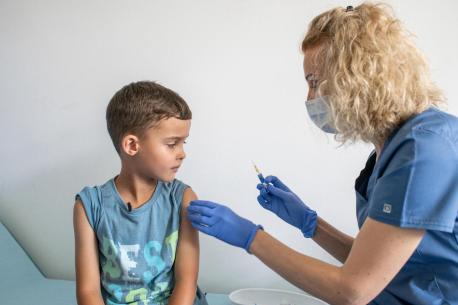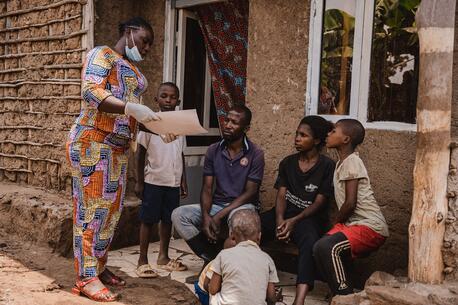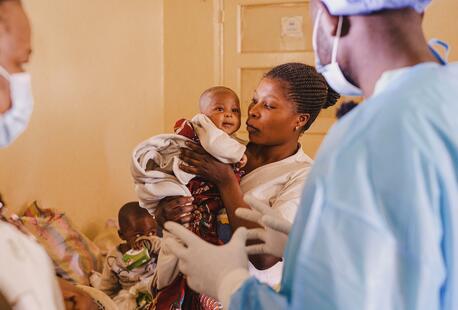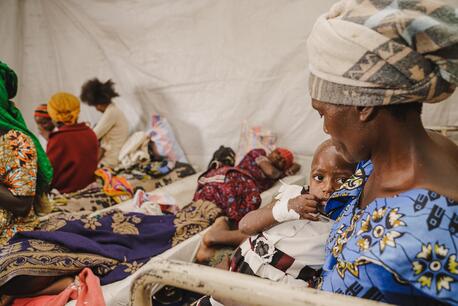
The Importance of Vaccinating Every Child
In this year's State of the World's Children report, UNICEF delves into the dangerous backslide in child immunization rates and the urgent need to reach every child with essential vaccines.
67 million children missed out on critical vaccines in last three years
UNICEF renewed its commitment to ensure that every child gets vaccinated with the release of its 2023 State of the World’s Children (SOWC) report on Thursday — calling on governments to act urgently to shore up flagging immunization services, and announcing a new catch-up and recovery campaign to help them do it.
Vaccination coverage dropped sharply during the COVID-19 pandemic, leaving millions more children unprotected against some of childhood’s most serious diseases, according to the report. The deteriorating situation reflects not just pandemic-related disruptions in primary health care services, however; declines in immunization are also the result of conflict, fragility and extreme weather events in Afghanistan, Ethiopia, Myanmar, Somalia, Ukraine and other countries, the report states.
SOWC report declares a red alert for children's health
While there were some early signs of recovery in childhood immunization services in a number of countries in 2022, the report notes, urgent action is needed to make up lost ground. "The world is facing a red alert for children’s health," the report's coauthors wrote. "Catch-up and recovery is urgently needed to vaccinate the children missed and to avoid further backsliding."
Gap in coverage significantly increase the risk of outbreaks of deadly diseases; 95 per cent of a community needs to be immunized in order to reach herd immunity. Some 67 million children missed out entirely or partially on routine immunization between 2019 and 2021, and 48 million of them missed out entirely, according to the report.

"State of the World's Children 2023: For every child, vaccination" provides an in-depth analysis of the data and provides guidance on what countries can do going forward to increase coverage and close dangerous immunity gaps. Read the full report.
By the numbers: stagnant or declining vaccination rates in 112 countries
Global coverage of the third dose of the diphtheria-tetanus-pertussis vaccine (DTP3) — the best indicator of immunization coverage, because those who received this one are highly likely to have received all the other routine vaccinations — fell 5 percentage points, from 86 percent in 2019 to 81 percent in 2021 – the lowest level since 2008.
In 112 countries, DTP3 coverage has been stagnant or declined since 2019 — with 62 of those countries declining by at least 5 percentage points — according to WHO/UNICEF estimates.
The upshot: 25 million children were unvaccinated — or under-vaccinated — in 2021, 18 million of whom did not receive a single dose of any vaccine — an increase in 'zero dose' children by 5 million over just two years.
Making up lost ground
The challenge of reaching these children will be substantial. While some will eventually be vaccinated through catch-up campaigns, most will not receive full vaccination, and some will receive none. And as they pass the age when children are typically vaccinated, it will become ever harder to reach them through conventional campaigns and routine immunization programs, according to the report.

Where are the unvaccinated children?
According to UNICEF and WHO, 60 percent of the unvaccinated or under-vaccinated children live in just 10 countries: India, Nigeria, Indonesia, Ethiopia, Philippines, Democratic Republic of the Congo, Brazil, Pakistan, Angola and Myanmar.
UNICEF will continue to focus its immunization work, alongside government authorities and other partners, in these and other low- and middle-income countries where risks are highest and health systems need also need support to step up vaccination service delivery.
Why vaccines matter
Vaccination is one of humanity’s greatest public health achievements — one of the most successful interventions, and certainly one of the most cost-effective.
It is the first line of defense against a whole host of diseases: measles, diphtheria, tetanus, whooping cough (pertussis), tuberculosis, hepatitis, flu, polio, yellow fever, dengue, cervical cancer. It can protect against pneumonia, which kills more than 700,000 children a year. It can prevent diarrhea, which kills more than 484,000 a year.
It not only saves an estimated 4.4 million lives annually. It also improves the health and wealth of individuals and communities. It helps children not only survive, but also thrive.

Longer term, protecting children against disease can result in huge savings in spending on health care, and can support societies and economies in developing human capital and productivity.
The power of immunization was demonstrated during the COVID-19 pandemic. The speedy development of vaccines against COVID-19 and quick application resulted in astounding global impact: At least two thirds of the world’s population has been immunized against COVID-19 — preventing an estimated 20 million deaths globally. UNICEF played a leading role in what was the largest vaccine supply operation in history, procuring and delivering almost two billion vaccine doses to 146 countries and territories.
COVID-19's collateral damage: disrupting routine immunization programs
But while the effort to immunize against COVID-19 is seen as a big success, the pandemic resulted in a serious rollback in routine vaccinations that protect children from other diseases. Gains in child immunization had already stalled in years prior, stifled by conflict, climate change and misinformation; the spread of COVID-19 only made things worse, wiping out three decades of progress.
UNICEF estimates that 67 million children missed routine immunizations for measles, polio and other preventable diseases between 2019 and 2021, contributing to a rising number of outbreaks of measles, polio, diphtheria and yellow fever, and thousands of deaths.

Many hurdles to overcome to improve access to vaccines for children
Whether children are vaccinated or not is often the result of deep inequities – between rich and poor, between men and women, between communities at the center of power and communities on the margins.
Children from marginalized communities who live in the remotest of rural areas, urban slums, peripheral urban settlements, crisis-affected areas, and migrant and refugee communities are among the least likely to be vaccinated. They are confronted daily by socioeconomic barriers to immunization: poverty, gender and ethnic marginalization, conflict, crisis and displacement.
The increasingly disastrous impacts of climate change — droughts and floods, displacement and migration, food insecurity — continue to interfere with child immunization. Vaccine misinformation and disinformation and vaccine hesitancy all continue to be factors.
All of these hurdles must be overcome to increase access and uptake.
Rolling back the rollback: how UNICEF is building back immunity
The Immunization Agenda 2030 developed by the World Health Organization (WHO) and supported by UNICEF and other partners, aims to halve the number of children who miss out on essential vaccines and to achieve 90 percent coverage for key lifesaving vaccines. The plan also aims to introduce 500 new vaccines in low- and middle-income countries.
If the agenda is met, it will save an estimated 50 million lives by 2030. UNICEF is working with WHO and other partners to support the plan by making sure every child is vaccinated.

UNICEF’s global strategy for increasing vaccination coverage aims for a world where everyone, everywhere, at every age, fully benefits from vaccines for good health and well-being.
Strategies for solutions seek to:
Strengthen primary health care and increase community engagement in the design and delivery of primary health care
Embed immunization into primary health care as the basis for achieving both high vaccination coverage and universal health care
Engage communities to design and deliver vaccination interventions and bolster support, increase success and stem the influence of misinformation
Support health workers, increase the health workforce and provide training and reliable pay and opportunities
Build vaccine confidence and trust with social listening, communication, pro-vaccine education and public messaging
Promote vaccine innovation to develop and improve vaccines, crucial to ensuring every child receives life-saving immunizations
Increase spending on immunization and health and keep them a priority for governments, especially in times of fiscal pressure
Build resilient systems and shock-proof them for the future to respond to outbreaks while continuing to provide essential services

Vaccination accessibility, availability, affordability, and trust are critical factors that influence whether parents and caregivers immunize their children. Achieving the goal of vaccinating every child will require commitment— from governments and individuals.
The COVID-19 pandemic provided some useful lessons on how to do immunization better, UNICEF points out in the SOWC report, but without political will – global, national and local – children will be left unprotected.
The case for donor support: invest in child immunization, because no one is safe until everyone is safe
Climate change and other impediments to vaccination exacerbates infectious disease and increases the risk of children’s exposure to it. Failure to immunize children undermines their right to what the Convention on the Rights of the Child describes as “the enjoyment of the highest attainable standard of health.”
As the world’s largest organization for children and the leading procurer of vaccines in the world, UNICEF has a unique perspective on how to reach children with vaccines — reaching 45 percent of children under age 5 in over 100 countries every year.
But in a post-COVID world, global financial pressures make prioritizing investment in immunization vital in regaining lost ground. Donor contributions remain fundamental to the success of lifesaving immunization efforts.
Supporting UNICEF’s immunization work not only helps deliver lifesaving protection to the children of today; it helps protect children in the future, through improvements in overall primary health care service delivery. That's because, while helping to address immediate needs in children's health, UNICEF also focuses on helping governments strengthen their health systems — making them stronger, more efficient and more sustainable, and gradually less reliant on donor support.
“Reaching our goal – to vaccinate every child – will require a real commitment by governments," the SOWC report's authors wrote. "Some of this change will be technical – making better use of data, improving communication and outreach, and strengthening cold chains. Some will require difficult conversations about financing and challenging trade-offs, including by national governments, donors and others, on how best to fund primary health care and immunization services and how to make them more resilient to future shocks.
"And some will force societies and communities to examine their fundamental values."
Help UNICEF accelerate global efforts to provide vulnerable children with lifesaving protection against vaccine-preventable diseases. Your contribution can help UNICEF and partners ensure every child is immunized. Please donate.
HOW TO HELP
There are many ways to make a difference
War, famine, poverty, natural disasters — threats to the world's children keep coming. But UNICEF won't stop working to keep children healthy and safe.
UNICEF works in over 190 countries and territories — more places than any other children's organization. UNICEF has the world's largest humanitarian warehouse and, when disaster strikes, can get supplies almost anywhere within 72 hours. Constantly innovating, always advocating for a better world for children, UNICEF works to ensure that every child can grow up healthy, educated, protected and respected.
Would you like to help give all children the opportunity to reach their full potential? There are many ways to get involved.





